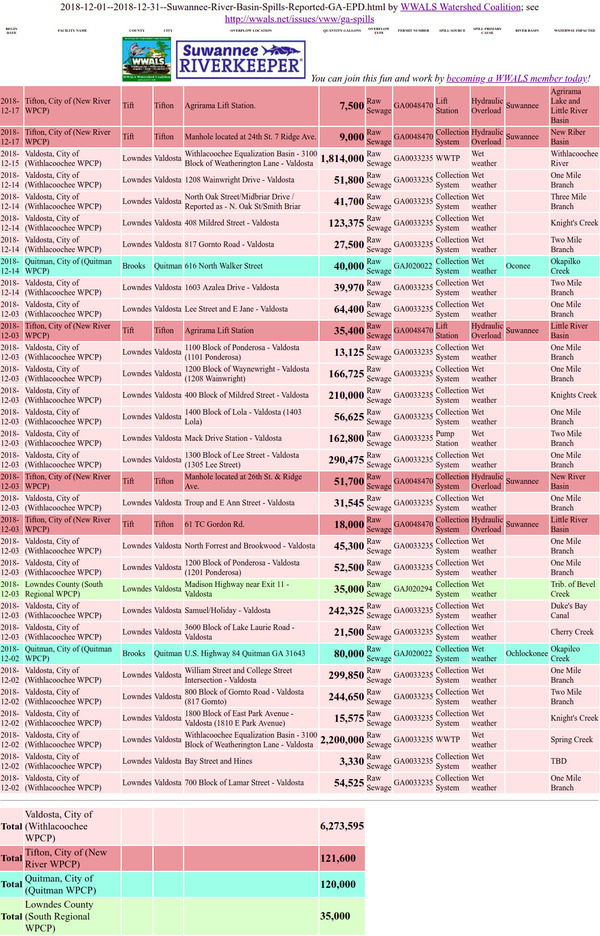Here are the plans for the new catch basin at the entrance of Valdosta’s Withlacoochee Wastewater Treatment Plant (WWTP) (see also PDF), obtained via open records request from Valdosta. At least we finally know how big it is: 7.26 million gallons. But is that big enough?
The catch basin is a good idea, and I commend Valdosta on implementing it. However:
This catch basin would have done nothing to prevent Valdosta’s record December 2019 raw sewage spill into Sugar Creek, nor its December 2018 spills of 218,075 gallons into Onemile Branch at Wainwright Drive.
Those and many other spills happened before the sewage ever got near the WWTP.

For the WWALS automated updates on GA-EPD Sewage Spills Reports,
see
wwals.net/issues/vww/ga-spills/.
What I don’t find in this document is what I’ve been asking for at least since April: how does Valdosta know that will be big enough? Where is any model of how much incoming water will be produced by how much rainfall on Valdosta?
According to Valdosta Utilities Director Darryl Muse on July 10, 2019, in a meeting with the Valdosta City Council and a Task Force of the dozen downstream Florida counties, EPD required Valdosta to supply design criteria for “if it rains X amount; we have this amount of the flood; how much would that structure that you are designing, how much load would that take off the facility.”
These tables, for example, seem to be about how much the catch basin will hold at various depths.
It’s prudent that the designed flow into this catch basin not to require pumping:
![[1.0 Project Purpose and Objectives Narrative]](https://www.wwals.net/pictures/2019-09-01--catch-basin-vld-wwtp/ORR-2019-357-John-Quarterman-Secondary-EQ-DDR--Final-123019-0002.jpg)
1.0 Project Purpose and Objectives Narrative
And they admit that overflows are still possible:
Based on the design information above, peak hourly flows to the plant greater than 8.3 hours will more than likely result in an overflow of the existing equalization basin. The new secondary equalization basin will provide more than double the available storage for extended periods of operation at the peak hourly flow.
![[3.0 Flow Pattern During Draining and Filling Operations/Calculations For Secondary]](https://www.wwals.net/pictures/2019-09-01--catch-basin-vld-wwtp/ORR-2019-357-John-Quarterman-Secondary-EQ-DDR--Final-123019-0003.jpg)
3.0 Flow Pattern During Draining and Filling Operations/Calculations For Secondary
But how much rain would it take to cause such an overflow to happen? Have such rains occured before? How likely are they to happen in the future?
No questions like those seem to have been addressed.
Yet this is the Valdosta WWTP catch basin plan that has been approved by the Georgia Environmental Protection Division.
-jsq, John S. Quarterman, Suwannee RIVERKEEPER®
You can join this fun and work by becoming a WWALS member today!
Short Link:

![[FORWARD FLOW SCHEMATIC]](https://www.wwals.net/pictures/2019-09-01--catch-basin-vld-wwtp/ORR-2019-357-John-Quarterman-Secondary-EQ-DDR--Final-123019-0007.jpg)
![[SITE and UTILITY PLAN]](https://www.wwals.net/pictures/2019-09-01--catch-basin-vld-wwtp/ORR-2019-357-John-Quarterman-Secondary-EQ-DDR--Final-123019-0005.jpg)
![[Lime and broken concrete]](https://www.wwals.net/pictures/2019-02-10--wq-testing-one-mile-branch/20190210_171842.jpg)

![[Pond Report]](https://www.wwals.net/pictures/2019-09-01--catch-basin-vld-wwtp/ORR-2019-357-John-Quarterman-Secondary-EQ-DDR--Final-123019-0006.jpg)